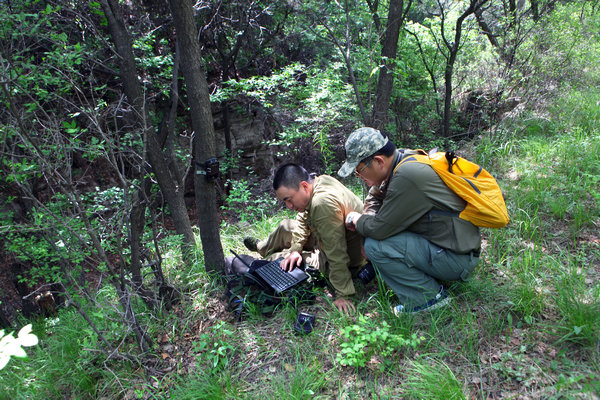Small group claws its way up
Updated: 2016-03-25 08:39
By Xu Lin(China Daily)
|
|||||||||
 |
|
Song Dazhao (left) and Wan Shaoping observe the landscape and the vegetation of the area to learn about leopards' habitat via Google Earth during a field trip.[Photo provided to China Daily] |
In 2008, the Chinese Felid Conservation Alliance began building a camera-trapping network to monitor North Chinese leopards in Shanxi province. Today, it says there are more than a dozen members of the species in the area. Xu Lin reports.
In the first scene you can see two leopards walking past in a mountain forest. Then, one pauses after it notices something - an infrared camera. It claws at it several times until it falls off its mount.
This is among the scenes captured by more than 100 infrared cameras in the central Taihang Mountains in Shanxi province.
In 2008, the Beijing-based Chinese Felid Conservation Alliance began to build its camera-trapping network there to monitor North Chinese leopards in an area covering about 300 square kilometers.
"Leopards are awe-inspiring and pretty animals. It's not difficult to film them, but what we want is for them to live unharmed and for their habitats to be protected," says Song Dazhao, 39, cofounder of the nonprofit organization.
In 2011, the CFCA and a biodiversity research team of Beijing Normal University started a monitoring program for the leopard population there.
It was the first research project on the subspecies that's native to China.
The project aimed to study the animal and figure out ways to boost the leopard population in China.
In May 2014, the cameras captured a female leopard and the researchers wondered whether it was pregnant.
About half a year later, they were excited to see the leopard again, together with two cubs.
"We love big cats. And when we see cubs we feel that what we are doing is worth it," says Song.
Leopards are solitary animals and seek courtship only during breeding season.
But their monitoring has begun to reveal other sides to the animal.
According to Wan Shao-ping, director of the North Chinese leopards project at the CFCA, the leopards like to lie on their backs with their legs in the air and enjoy the sunshine. They love playing with twigs and the males typically fight each other for territory.
Cubs are usually born in a litter of two in April or May, and become independent when they are around a year old. Their main prey are roe deer and wild boars.
As of now, the CFCA has only six members and they are together because they love nature and big cats.
Related Stories
Animal Kingdoms 2016-03-18 08:03
Nanyang to add investment of 27.5b yuan in animal husbandry 2016-03-23 17:25
Shangfang Hill Animal World to open soon 2016-03-08 17:00
The Chinese zodiac: Which animal are you? 2016-02-02 14:23
Dolphin circus sparks animal cruelty debate 2016-01-22 08:14
Today's Top News
President optimistic for Sino-German cooperation
Info sharing 'is key' as Europe faces terror threat
Uneasy times as Belgium mourns the dead
Belgian bombing suspect still at large: Prosecutor
Belgian media withdraws reports of suspect's arrest
Brussels bombers were brothers El Bakraoui
Chinese citizens in Belgium get help after attack
Europe ramps up security in wake of Brussels attacks
Hot Topics
Lunar probe , China growth forecasts, Emission rules get tougher, China seen through 'colored lens', International board,
Editor's Picks

|

|

|

|

|

|






